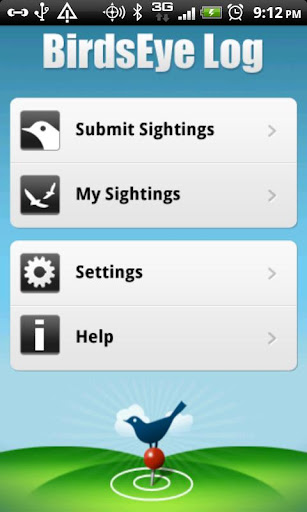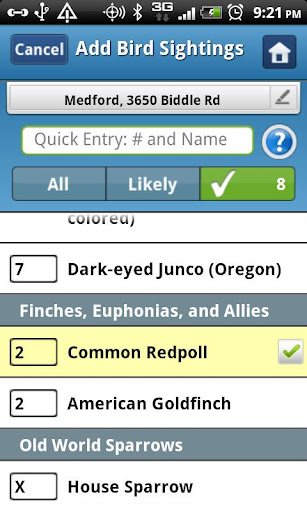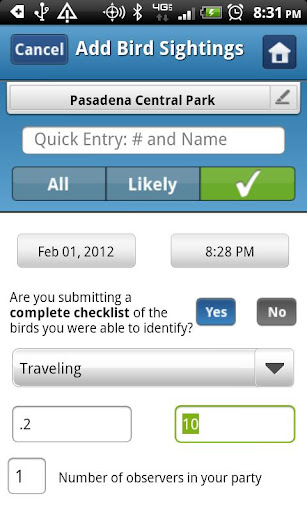About a month ago I downloaded the "BirdsEye Log" app for my Android phone (there's a similar app for the iPhone as well). I've become convinced that this little app is the best way to log your bird sightings into
eBird.org website. Now before reviewing the app, perhaps I should give a few reasons to enter your birding data into eBird:
- Logging your observation data lets you keep a running life list (as well as totals for each year, state, county, etc). This allows you to revisit where you saw what so that you can know where to return when in the future. eBird's database is pretty sophisticated and allows you to get information from your own sightings you may not have seen yourself.
- Logging your observation data allows others to benefit from your findings. Others can see what you've logged, so it's important to be accurate.
- Logging your observation data to eBird lets the Cornell Lab of Ornithology use data from you and others to track bird migrations, population changes, etc.
Over the last month I've become increasingly dependent on the BirdsEye Log app. At first I considered it a convenient way to enter data after birding. When I finished birding, I would usually find the closest Subway and enter data into the app and submit the data. But just recently I've discovered that the best way to use the app is in the field. It's quick and easy, and it allows you to keep more accurate data. Here's what I do:
 |
| BirdsEye Log |
- When I arrive at my birding location I open the app and hit "Submit Sightings." This will take me to a map, where it will find my location and show me personal locations and hotspots near me. I click the one I want and hit "continue."
 |
| BirdsEye Log |
- It then asks for the date and time. Since I've just started my birding event, I can usually just hit "OK" to continue.
- It then generates a "Likely" list of birds that I might see at my location. There are two ways to enter data:
a. You can scroll through the list, click on the species you see and enter the number for the species count (or an X for presence of species). But I've found this approach cumbersome.
b. There's a "Quick Entry" on the top of the screen. If you type in the count and the species, it will automatically add it to your log.
 |
| BirdsEye Log |
- You don't have to enter the entire species name. You can simply type "1 dow" and it will show you "Downy Woodpecker" as a choice. Hit it and it will enter 1 Downy Woodpecker into your log. If you begin with "2 whi" it will find more than one species, but you can scroll through the list it gives you until you find "White-eyed Vireo." It will search the middle of words too, so if you start with "3 car" it will show you "Northern Cardinal" as an option.
- If you see the same species again after logging it, you can simply type in the number and species, and it will add that new sighting to your current total. So typing in "2 dow" will let you raise your total of Downy Woodpeckers to 3. So cool! You don't have to keep running totals in your head or scratches on paper. Let the app do the math while you do the birding.
- Save your log periodically. If something happens, you may lose your unsaved data.
- If you hit the check mark icon, it will let you review a list of your sightings and enter the data eBird wants, like distance, duration, etc. I keep it on this view so I can quickly review my log to make sure I haven't made any mistakes in data entry.
 |
| BirdsEye Log |
- When you submit data, it uploads your findings to eBird, and it keeps a list on your phone for you to review. At this moment in time, you cannot edit this list once you hit submit, so review your list carefully before submitting. Of course, you can always go to the eBird.org website to edit mistakes, but I prefer not to make them.
I've found that, now that I have this app, I enter more checklists to eBird, especially incidental observations I see while driving, etc. I saw 4 Swallow-tailed Kites yesterday from my church parking lot. I added them into BirdsEye before I forgot. Make sure your phone is charged when you use this method (I've learned that the hard way). As of right now, the app does not allow a two-way sync. So any changes you make to your checklist on the eBird website will not appear on your phone. The Android app costs $10, which I thought was a little steep, but I now believe it's worth it.
Note: All screen shots come from the Android marketplace, or "Google Play" I guess it's called now.
Great review! I've been wondering how that field data entry worked. That sounds really cool.
ReplyDeleteThanks, Robert! It's very convenient on Android--I suspect the iPhone version will be just as easy. Now that I've figured out it adds for me, I can't imagine going back.
DeleteI just downloaded the app for my ipod touch yesterday. I have been waiting years for this..I absolutely love it.
ReplyDeleteI use mine almost every day, and the new version is even better.
Delete